
Redox Biology
metrics 2024
Pioneering Insights into the Role of Redox in Health and Disease
Introduction
Redox Biology, published by Elsevier, stands as a premier open-access journal in the fields of biochemistry, clinical biochemistry, and organic chemistry. Since its inception in 2013, the journal has provided a vibrant platform for researchers to disseminate high-quality findings that advance our understanding of redox biology and its implications in health and disease. With an impressive impact factor and ranked Q1 across multiple chemistry disciplines, Redox Biology is recognized for its significant contributions to the scientific community, drawing attention from a global audience. This journal aims to foster a rich dialogue among scientists, clinicians, and students, emphasizing the critical role of redox processes in biological systems. Located in the Netherlands, Redox Biology has become an essential resource for those seeking to explore the nuanced interactions of reactive species and their roles in cellular function and pathology, making it a must-read for anyone interested in the forefront of biochemistry research.
Metrics 2024
 3.01
3.01 10.70
10.70 11.70
11.70 137
137Metrics History
Rank 2024
Scopus
IF (Web Of Science)
JCI (Web Of Science)
Quartile History
Similar Journals
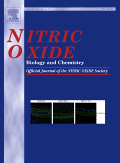
NITRIC OXIDE-BIOLOGY AND CHEMISTRY
Connecting the Dots Between Nitric Oxide and Cancer ResearchNITRIC OXIDE-BIOLOGY AND CHEMISTRY is a premier journal dedicated to the exploration of the multifaceted roles of nitric oxide in biological systems, contributing significantly to the fields of biochemistry, physiology, and cancer research. Published by Academic Press Inc, Elsevier Science, the journal boasts a solid reputation, evidenced by its 2023 quartile rankings, including Q2 in Biochemistry, Clinical Biochemistry, and Physiology, as well as Q3 in Cancer Research. Researchers and professionals seeking to stay abreast of the latest developments can benefit from its rigorous peer-reviewed articles and insightful reviews, which span a convergence of studies from 1997 to 2024. Although not an open-access journal, it provides ample opportunities for institutional subscriptions and ensures a global reach, facilitating the dissemination of vital scientific knowledge. The journal's impact is further underscored by its impressive Scopus rankings, reaffirming its importance as a key resource for scholars intent on advancing their understanding of nitric oxide's biological significance.
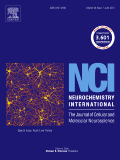
NEUROCHEMISTRY INTERNATIONAL
Pioneering Discoveries in Neurochemistry and HealthNEUROCHEMISTRY INTERNATIONAL, published by Pergamon-Elsevier Science Ltd, offers a premier platform for researchers and professionals in the realms of cell biology and cellular and molecular neuroscience. Established in 1980 and continuing its passion for advancing the field, this esteemed journal enhances scientific collaboration with a notable 2023 Q2 ranking in both relevant categories, placing it among the top-tier publications in its discipline with a Scopus rank of 23/97 for Cellular and Molecular Neuroscience. With its focus on groundbreaking research, the journal provides a wealth of vital data and insights that drive forward our understanding of neurochemistry and its implications in health and disease. While not an Open Access journal, NEUROCHEMISTRY INTERNATIONAL is integral for professionals, academics, and students aiming to stay at the forefront of neurobiological research innovations, making significant contributions to both academia and clinical applications.

STRESS-THE INTERNATIONAL JOURNAL ON THE BIOLOGY OF STRESS
Illuminating the Biological Foundations of StressSTRESS - THE INTERNATIONAL JOURNAL ON THE BIOLOGY OF STRESS, published by Taylor & Francis Ltd, is an esteemed open-access journal dedicated to advancing our understanding of stress and its biological underpinnings. Established in 1996 and continuing until 2024, this journal is pivotal in the exploration of stress across multiple dimensions, including its impact on mental health, neurobiology, and endocrine systems. With an impressive categorization in Q2 and Q3 quartiles across various fields such as Behavioral Neuroscience, Psychiatry, and Physiology, STRESS ranks commendably within its discipline, positioning itself as a vital resource for researchers and professionals alike. As of 2022, the journal's open access policy enhances visibility and accessibility, fostering a broader dissemination of knowledge. The journal invites submissions from a diverse range of disciplines, aiming to bridge gaps across fields and encourage interdisciplinary collaboration. By addressing the multifaceted nature of stress, STRESS remains essential for those eager to contribute to this dynamic and critical area of research.

BIOCHIMICA ET BIOPHYSICA ACTA-BIOENERGETICS
Fueling Scientific Collaboration in BioenergeticsBIOCHIMICA ET BIOPHYSICA ACTA-BIOENERGETICS is a prestigious journal published by Elsevier, dedicated to advancing the fields of biochemistry, biophysics, and cell biology. Established in 1967, this journal is committed to disseminating high-quality research that unveils the molecular mechanisms of bioenergetics, encompassing a wide range of topics from mitochondrial function to energy metabolism. With an exceptional impact factor and a current ranking in the Q1 quartile across multiple categories—specifically ranked #13 in Biophysics and featuring strong positions in Biochemistry and Cell Biology—this journal is recognized for its influential contributions to the scientific community. Scholars, researchers, and students globally benefit from its rigorous peer-review process and access options, although it is not currently open access. By providing a platform for innovative research, BIOCHIMICA ET BIOPHYSICA ACTA-BIOENERGETICS plays a critical role in fostering scientific advancement and collaboration among professionals in the field.

JOURNAL OF TRACE ELEMENTS IN MEDICINE AND BIOLOGY
Championing Pioneering Studies in Trace Elements and Biological SystemsThe JOURNAL OF TRACE ELEMENTS IN MEDICINE AND BIOLOGY, published by Elsevier GmbH, stands as a leading platform for disseminating pivotal research in the interdisciplinary field that bridges biochemistry, inorganic chemistry, and molecular medicine. With an impact factor reflective of its high-quality submissions and significant contribution to the scientific community, this journal currently holds a Q2 ranking in Biochemistry and a Q1 ranking in Inorganic Chemistry, underlining its esteemed status among peers. Since its inception in 1995 and continuing through to 2024, the journal has fostered a dynamic discourse on the fundamental roles of trace elements in biological systems, incorporating studies that range from their biochemical functions to their impact on health and disease. Researchers, professionals, and students alike can access a wealth of knowledge, missing Open Access options notwithstanding, making it indispensable for those at the forefront of scientific investigation in medicine and biology.
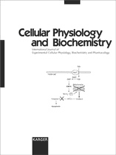
CELLULAR PHYSIOLOGY AND BIOCHEMISTRY
Empowering Discoveries in Molecular BiologyCellular Physiology and Biochemistry is a premier Open Access journal published by the prestigious Cell Physiol Biochem Press GmbH & Co, dedicated to advancing research in the fields of physiology, biochemistry, and molecular biology. Since its inception in 1987 and transitioning to an Open Access model in 2013, the journal has established itself as a vital resource for the dissemination of high-quality research and reviews, showcasing innovative methodologies and groundbreaking findings in cellular processes. With an impressive ranking in the 2023 Scopus category as Q2 in Physiology and a robust percentile of 61, Cellular Physiology and Biochemistry is committed to fostering academic dialogue among researchers, professionals, and students alike. This journal not only provides unrestricted access to its articles, but also promotes the global sharing of knowledge, which is essential for the advancement of our understanding in these vital scientific areas. The journal's editorial team is dedicated to ensuring the highest standards of academic rigor and relevance, making it an indispensable addition to the libraries of those engaged in the life sciences.
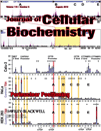
JOURNAL OF CELLULAR BIOCHEMISTRY
Elevating Biochemical Insights for Tomorrow's ScienceJournal of Cellular Biochemistry is a premier academic journal dedicated to advancing the field of biochemistry and cellular biology. Published by Wiley, this influential journal has a significant impact factor that underscores its relevance and authority within the scientific community. With its ISSN 0730-2312 and E-ISSN 1097-4644, the journal has been on the frontier of research since its inception in 1982, and is expected to continue publishing cutting-edge studies through 2024. As evidenced by its ranking in the 2023 Scopus Quartiles, it holds a rank of Q2 in Biochemistry and Q3 in both Cell and Molecular Biology, placing it among the top tiers of scientific journals in these disciplines. The Journal of Cellular Biochemistry serves as a vital resource for researchers, professionals, and students alike, providing a platform for the dissemination of innovative ideas and findings that shape our understanding of cellular processes and biochemical pathways. Though it does not currently offer Open Access options, its robust peer-review process ensures that each publication meets the highest academic standards, thus solidifying its esteemed position in the landscape of biochemical research.

CELL BIOLOGY INTERNATIONAL
Championing Excellence in Cell Biology ResearchCELL BIOLOGY INTERNATIONAL is a prestigious academic journal dedicated to the rapidly evolving field of cell biology, publishing high-quality research aimed at understanding cellular processes and their implications in various biological contexts. Published by Wiley, this journal has established its relevance with an H-Index that reflects its robust citation impact and a commendable Scopus Rank of #111 out of 285 in the field of Biochemistry, Genetics, and Molecular Biology, positioning it in the 61st percentile. Although it operates under a traditional subscription model, its influential insights are crucial for researchers, professionals, and students alike who are seeking cutting-edge developments in cellular mechanisms and their applications in medicine. The journal spans contributions dating back to 1993, providing a rich archive of knowledge that continues to shape the discourse within the scientific community. With a strong category ranking of Q3 in Cell Biology and Q2 in Medicine (miscellaneous) as of 2023, CELL BIOLOGY INTERNATIONAL stands as a reliable platform for disseminating transformative science in the cellular domain.

JOURNAL OF BIOENERGETICS AND BIOMEMBRANES
Connecting Discoveries in Energy and Membrane BiologyJOURNAL OF BIOENERGETICS AND BIOMEMBRANES, published by SPRINGER/PLENUM PUBLISHERS, is a leading journal dedicated to the study of bioenergetics and biomembranes, covering essential topics such as cellular energy transformation and membrane dynamics. Since its inception in 1976, the journal has developed a robust reputation within the scientific community, currently holding a Q3 ranking in Cell Biology and a Q2 ranking in Physiology for 2023. Boasting a prestigious Scopus Rank in both Biochemistry and Physiology, it serves as a crucial platform for disseminating pioneering research findings. With its commitment to quality and innovation, the journal plays a significant role in advancing our understanding of the fundamental processes that underlie life at the cellular level. Although it does not offer open access options, the journal remains accessible through universities and research institutions, ensuring that vital research is widely shared among scholars, professionals, and students alike. The JOURNAL OF BIOENERGETICS AND BIOMEMBRANES is essential for anyone seeking to contribute to or stay informed about developments in this dynamic field.
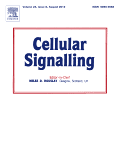
CELLULAR SIGNALLING
Elevating Insights into Cellular CommunicationCELLULAR SIGNALLING, published by Elsevier Science Inc, is a premier journal within the realm of Cell Biology, boasting an impressive Q2 category ranking as of 2023. With an ISSN of 0898-6568 and an E-ISSN of 1873-3913, the journal has established itself as a critical platform for advancing the understanding of cellular mechanisms and signal transduction pathways since its inception in 1989. Covering a vast array of topics in Biochemistry, Genetics, and Molecular Biology, it ranks notably at 87 out of 285 in the Scopus list, placing it in the 69th percentile among its peers. The journal serves as an invaluable resource for researchers, professionals, and students seeking high-quality, impactful studies that drive forward the field of cellular biology. While it operates under traditional subscription access, its highlights include rigorous peer-reviewed articles, reviews, and insights that continue to shape current scientific discourse.